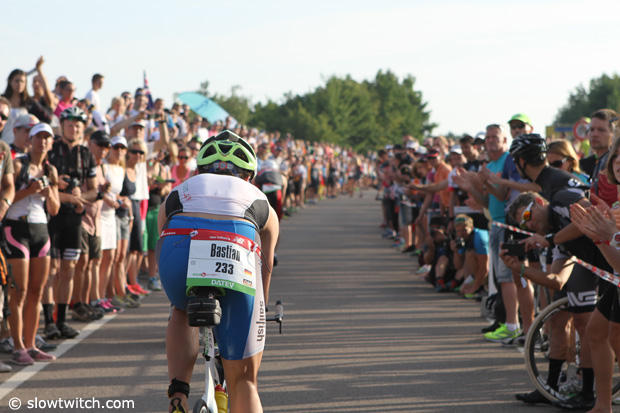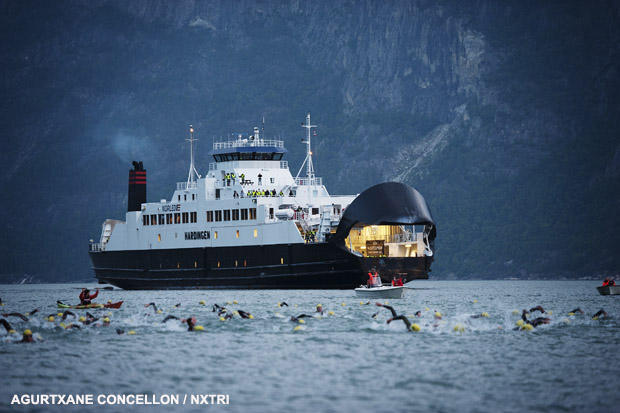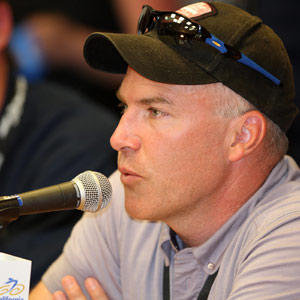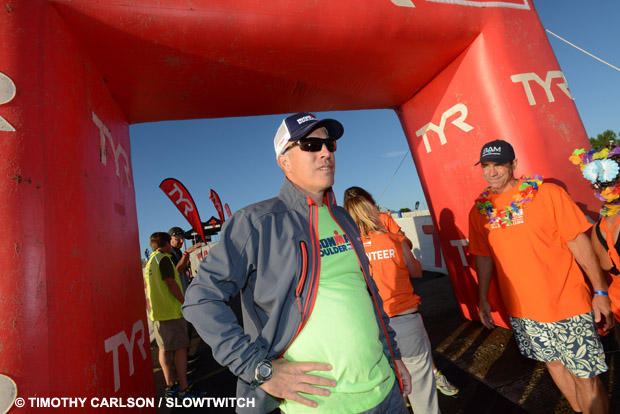Monuments
Before commencing I'd like to revise and extend my remarks on my initial installment on private equity in triathlon, specifically about the nature of the debt service Ironman now faces.
In Facebook comments appending my article on Ironman's recap readers offered the option of this being a "bullet loan" while I immediately and naïvely jumped to the conclusion this was a fully amortized loan. A bullet loan is an almost interest-only loan, which makes the monthly payment more like $1 million with a balloon payment due at the end of the loan's maturity.
If this $220 million loan is bullet loan – and it almost certainly is – it doesn't change my calculation of Ironman's cash flow but it does change my guess as to Ironman's margins. If, "there is free cash flow will be over 10% of debt each year over the next several years," per Moody's, then it would follow that Ironman is earning an EBITDA of roughly $3 to $4 million per month instead of $5 million/mo, assuming debt service is less than or not much more than $1 million per month via a bullet loan instead of $3 million a month (or more) on a fully amortized loan.
My thesis remains the same in either case, that while PEP has repaid its investors with this loan, and perhaps established a kind of "minimum floor bid" to warn away unrealistic suitors, it has burdened Ironman with this debt at a time when it thinks Ironman can afford to pay it out of operations.
Okay, now…
I feel like de Tocqueville, coming over to observe how this experiment in private equity is doing. "America is great because she is good," wrote de Toqueville famously. "If America ceases to be good, America will cease to be great." I am asking in my best French accent, Is private equity "good"?
In answering that question I will take us to the continent of de Tocqueville, to Paris-Roubaix, Liege-Bastogne-Liege, Milan-San Remo. These are so-called Spring Classics, and 4 of these plus 1 of the Fall Classics are also called "The Monuments." Liege-Bastogne-Liege is also called "La Doyenne" which is translated roughly "The Grand Dame." These are terms of reverence for events that have reached a hallowed place in popular culture, and are loved by their stakeholders.

When is a race, with no tangible assets, worth a premium? When it's a monument. What does the Boston Athletic Association own? Cones? Barricades? But who doesn't consider the Boston Marathon a brand equally durable as Proctor & Gamble?
Color and mud runs are the hottest thing going in mass participation sports, but in 8 to 10 years series like The Color Run and Color Me Rad will not, in my opinion, be among the largest run participant series in the U.S., as they now are. I don't mean to be critical. Color Me Rad was founded by the same folks who produce The Dirty Dash (analogous to mud runs). These people seem to be geniuses of identifying hot ideas and scaling them up quickly.
Triathlons are and should be more like the Boston Marathon than a color run. I honor races that mirror my commitment to the sport and this is what makes triathlon and the approach to the business of triathlon different than color or mud runs. You are the same way, whether you realize it or not (I know this because I note what races you tend to enter).
Monuments build slowly and they must be built with care, honoring all stakeholders, checking all the boxes. When you frequently change the money, the date, the venue, the course, or when you subordinate the race to some other business imperative, you cause stakeholders to question whether your brand is durable, and whether you own a brand or just a race permit. Your stakeholders will wonder whether you really have the stomach and patience to build a monument, and whether they should grow to love your monument when you obviously don't. You might attract customers, but not loyalty. Liege-Bastogne-Liege was first conducted in 1892. Can today's race organizations build monuments with similar longevity? Can their imaginations bend over the horizon?
My fear, 5 and 6 years ago, was that private equity as a style of ownership was incompatible with monument building. Was my fear rational? How has it turned out? Here's my interim opinion.
My very limited observation of private equity in triathlon – there are a number of companies in our industry that use this ownership or funding model – tells me that PE firms do not necessarily buy well, as in, when they buy assets they often overpay (at least by my assessment of the deal). I was surprised at this. I think it might be due to a private equity firm's urgency to perform its functions inside what is perceived as a fund's given time window, and because the strategic acquisitions and roll-ups that are the hallmarks of a growth company must occur inside that window.
What private equity firms do extremely well is scale a business up in a hurry. PE firms have an urgency that a company's prior owners probably did not have. Rock 'n Roll and Ironman are successes of private equity. Providence Equity Partners has exhibited an urgent ambition that Ironman needed (while noting that a phenomenon like Norseman has needed its time in the womb, and would have suffered had its lungs been subjected to "scaling up" before they were ready for that rush of oxygen).
Perhaps you see a dichotomy. How do you scale up a brand quickly, which has been necessary and helpful for Ironman and Rock 'n Roll, while taking care to painstakingly build monuments in each town? How do you build a monument – which takes decades of love, care and investment – when your hold period is 5 to 7 years?
It might seem hard to square this circle. But not impossible. We've been lucky. It is uncanny how many private equity deals get made in triathlon because one or more parties in the transaction were triathletes. Uncanny as in, every one I'm familiar with.
The same goes for public companies. Want to know why a $1.5 billion company like Deckers bought a company like Hoka One One, with then-revenues about the size of a typical retail store? Among other things, because all the Deckers execs are ex elite runners.
This doesn't mean the deals are unsound. When Cramer jumps up and down on your TV screen he's jumping in his Hokas. Those just now returning from the Outdoor Retailer trade show will tell you Hoka has changed the face of running.

Public company Life Time Fitness has an events division, heavy in triathlon, in some measure because its CEO, Bahram Akradi, is mad about triathlon. HITS is a private equity funded, organically built start-up (I understand that sounds oxymoronic) because its founder, Tom Struzzieri, is mad about triathlon.
When WTC was first formed, Jim Gills brought in a lot of people he knew to run the company, and danged if almost all of them didn't turn out to become triathletes. Not sprint triathletes, but Ironman finishers. I can't begin to name all the un- or marginally-athletic Ironman partners over the years who've gone to Kona to kick the tires of this license they bought only to return to the mainland stricken with the bug (and to eventually return to Kona as a race participant).
One thing inoculating triathlon against the shrapnel of bloodsport finance is the affection for triathlon by those who might be ambivalent were ours a different industry.
Still, private equity's mission is not to build and hold, but build and sell. We won't know what PEP has left us until we see who Ironman's buyer is, and in what shape the company is in. If that buyer assumes the debt, and still has to resort to a leveraged buy-out to swing the deal – further encumbering the company – that would be a big concern to me.
I'm not predicting this, and it's unlikely. Ironman's list of potential suitors include sports marketing groups like CAA, InFront and IMG (which produces Alcatraz, London and Abu Dhabi triathlons among others), sports conglomerates like ASO (Tour de France and Vuelta a Espana), RCS (Giro d'Italia and the 15,000-person Milan Marathon), and the European behemoth Lagardère Group. I can imagine interest from Sportfive, and Mr. Messick's old boss, AEG owner Phil Anschutz. Life Time's Bahram Akradi will take a look. I would be shocked if ardent triathlete Sami Inkinen doesn't at least peek in, as the company he co-founded, Trulia, is reported to have just been sold for gobs of money to Zillo.
Considering the list above, I doubt if Ironman is going to be sold to an underfunded company, or one uninterested in husbanding the Ironman experience, and I'm certain Andrew Messick will be retained to run the company. But if PEP can't get its asking price it can always try to take the company public. Ironman is just big enough to do that. If the stock rises everybody wins. If the stock drops maybe one of these entities above still gets Ironman via the same process Active just went through.
Either way, from simply my lay perspective, I'm unconcerned as long as Ironman is not encumbered with any more debt than this recent recapitalization; and assuming company revenues continue to grow, over the next half-dozen years, by roughly $25 million annually (this is my best guess as to its average annual growth over the past several years). This pattern of growth should allow Ironman to retire its current recapitalization, principle included, out of operations.
Is private equity "good" according to de Tocqueville's use of the word? Is goodness its strength? I wouldn't go that far, but its attachment to urgent growth has raised the bar for those in its competitive set. Is it innately bad, or evil, or born into original sin and destined to trespass? Honestly, this has so far not been my observation, but if new facts persuade me otherwise I reserve the right to repent from this opinion.
In sum, the optics of private equity belie the performance of private equity in triathlon, and I imagine the folks who work in private equity run into this a lot. The reality of private equity in triathlon has – so far – been a net plus.



